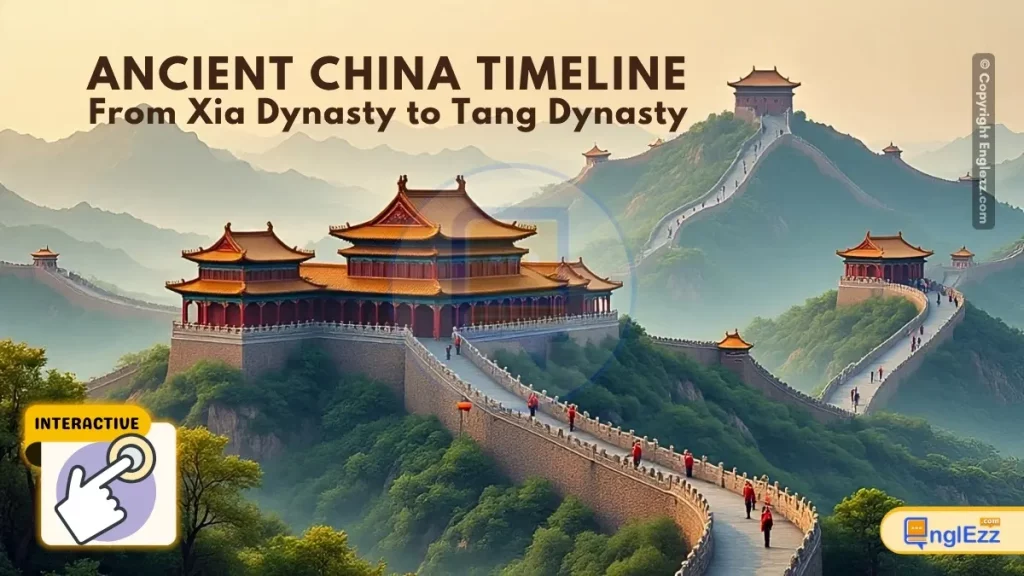
The Story of Ancient China Civilization
The Chinese Civilization Journey
Introduction
Explore The Rich History Of Ancient China In Interactive Format
The story of ancient Chinese civilization is one of remarkable continuity and transformation—from the legendary Xia Dynasty to the glorious Tang Dynasty. This journey spans over three millennia of cultural development, technological innovation, philosophical thought, and political evolution that shaped not only East Asia but the entire world.
China emerged from diverse influences along the Yellow River and Yangtze River valleys, developing unique systems of writing, governance, and social organization. Through successive dynasties, the Chinese people created enduring cultural traditions, advanced scientific knowledge, and built monumental architectural achievements.
This timeline explores key events and developments in ancient Chinese history, highlighting the complex interplay of political, social, economic, and cultural forces that shaped this great civilization. From the oracle bones of the Shang Dynasty to the Silk Road of the Tang Dynasty, we trace the evolution of Chinese civilization and its enduring legacy.
Xia & Shang Dynasties
The Xia Dynasty (c. 2070-1600 BCE) is considered China’s first dynasty, though its existence remains debated by historians. The Shang Dynasty (c. 1600-1046 BCE) that followed left archaeological evidence including oracle bones with early Chinese writing. This period saw the development of bronze technology, ancestor worship, and the beginnings of Chinese statecraft.
Han Dynasty
The Han Dynasty (206 BCE-220 CE) established many institutions that would define Chinese civilization. Confucianism became the state philosophy, the civil service examination system was developed, and the Silk Road connected China to the West. Han rulers expanded China’s territory and established patterns of centralized government that would endure for centuries.
Tang Dynasty
The Tang Dynasty (618-907 CE) represents a golden age of Chinese civilization. China became the world’s most populous and technologically advanced society. The capital Chang’an was the largest city in the world. Buddhism flourished alongside Confucianism and Daoism. Tang poetry, painting, and ceramics reached new heights of artistic achievement.
Explore the interactive Chinese civilization timeline below to discover key events that shaped this ancient culture. Click on any event to learn more, and test your knowledge with our quiz when you’re ready!
Interactive Ancient China Civilization Timeline
Shang Dynasty Begins
The Shang Dynasty emerges as the first historically confirmed Chinese dynasty, known for its bronze technology and oracle bone script.
Read moreThe Shang Dynasty (c. 1600-1046 BCE) represents the earliest Chinese dynasty supported by archaeological evidence. Centered in the Yellow River valley, the Shang established a sophisticated bronze-age civilization with a centralized government, a stratified society, and a distinctive writing system.
Key characteristics of Shang civilization included:
- Advanced bronze metallurgy for ritual vessels and weapons
- Oracle bone script – the earliest known form of Chinese writing
- Ancestor worship and divination practices
- Well-organized military with chariots
- Agricultural economy with millet as the staple crop
The Shang capital moved several times, with the last and most extensively excavated site at Yin (modern Anyang). Shang rulers claimed the Mandate of Heaven, a concept that would endure throughout Chinese history to justify dynastic rule.
The dynasty’s legacy includes the development of Chinese writing, the establishment of many cultural patterns that would persist for millennia, and technological achievements in metallurgy and craftsmanship.
Further Reading
- Keightley, David N. The Ancestral Landscape: Time, Space, and Community in Late Shang China (2000)
- Chang, Kwang-chih. Shang Civilization (1980)
Oracle Bone Script
The earliest known form of Chinese writing appears on oracle bones used for divination during the Shang Dynasty.
Read moreOracle bones are pieces of ox scapula or turtle plastron used for pyromancy – a form of divination – in ancient China, mainly during the late Shang dynasty. The diviner would inscribe questions on the bone, apply intense heat, and interpret the resulting cracks as answers from ancestral spirits.
These inscriptions represent the earliest known significant corpus of ancient Chinese writing, containing important historical information such as the complete royal genealogy of the Shang dynasty. The script demonstrates a fully developed writing system with over 4,000 characters, about 1,500 of which have been deciphered.
Key features of oracle bone script:
- Pictographic and logographic characters that evolved into modern Chinese writing
- Evidence of complex grammar and syntax
- Records of astronomical phenomena, weather, military campaigns, and rituals
- Provides names of Shang kings that match later historical accounts
The discovery of oracle bones in 1899 at Anyang revolutionized the study of early Chinese civilization, providing concrete evidence that confirmed the existence of the Shang dynasty, which had previously been considered semi-legendary by some scholars.
Further Reading
- Keightley, David N. Sources of Shang History: The Oracle-Bone Inscriptions of Bronze Age China (1978)
- Boltz, William G. The Origin and Early Development of the Chinese Writing System (1994)
Zhou Dynasty Founded
The Zhou people overthrow the Shang Dynasty, establishing the longest-lasting dynasty in Chinese history.
Read moreThe Zhou Dynasty (1046-256 BCE) was founded when King Wu of Zhou led a coalition of peoples to overthrow the last Shang king, Di Xin, at the Battle of Muye. The Zhou justified their rebellion with the concept of the “Mandate of Heaven,” which held that rulers governed by divine approval but could lose this mandate through misrule.
The Zhou period is traditionally divided into:
- Western Zhou (1046-771 BCE): A period of strong centralized rule from the capital Haojing
- Eastern Zhou (770-256 BCE): Divided into Spring and Autumn period (770-476 BCE) and Warring States period (475-221 BCE) when Zhou authority declined
The Zhou introduced several important innovations:
- The fengjian system of decentralized governance
- Advancements in iron technology
- Development of classical Chinese philosophy (Confucianism, Daoism, Legalism)
- Expansion of Chinese culture beyond the Yellow River valley
Though the Zhou kings eventually became figureheads during the Warring States period, their cultural and political legacy profoundly influenced later Chinese civilization.
Further Reading
- Shaughnessy, Edward L. Sources of Western Zhou History: Inscribed Bronze Vessels (1991)
- Li, Feng. Landscape and Power in Early China: The Crisis and Fall of the Western Zhou (2006)
Birth of Confucius
The philosopher Kong Qiu (Confucius) is born, whose teachings would become the foundation of Chinese ethical and political thought.
Read moreConfucius (551-479 BCE) was born in the state of Lu during the Spring and Autumn period. His philosophy, later known as Confucianism, emphasized personal and governmental morality, correctness of social relationships, justice, and sincerity.
Key concepts in Confucian thought include:
- Ren (仁): Humaneness, benevolence
- Li (礼): Proper ritual, etiquette
- Xiao (孝): Filial piety
- Junzi (君子): The ideal gentleman
- Zhengming (正名): Rectification of names
Confucius traveled through various states trying to find rulers who would adopt his ideas, with limited success during his lifetime. However, his teachings were preserved by disciples in the Analects and became enormously influential during the Han Dynasty and subsequent periods, forming the basis of Chinese education and government for two millennia.
Confucianism’s emphasis on hierarchy, education, and moral leadership profoundly shaped Chinese culture, society, and political institutions. It became one of the “Three Teachings” alongside Daoism and Buddhism that constituted traditional Chinese thought.
Further Reading
- Ivanhoe, Philip J. Confucian Moral Self Cultivation (2000)
- Brooks, E. Bruce and A. Taeko Brooks. The Original Analects: Sayings of Confucius and His Successors (1998)
Qin Unification of China
Qin Shi Huang conquers the warring states and becomes the first emperor of a unified China.
Read moreIn 221 BCE, after centuries of warfare during the Warring States period, the state of Qin emerged victorious under King Zheng, who proclaimed himself Qin Shi Huang (“First Emperor of Qin”). This marked the beginning of imperial China and the short-lived but highly influential Qin Dynasty (221-206 BCE).
Qin Shi Huang implemented sweeping reforms to consolidate his rule:
- Standardized weights, measures, and currency
- Established a uniform writing system
- Built extensive road networks
- Constructed the first version of the Great Wall
- Created a centralized bureaucracy
- Buried the famous Terracotta Army to guard his tomb
The Qin state philosophy was Legalism, which emphasized strict laws, harsh punishments, and absolute state power. The emperor ordered the burning of many philosophical texts (though technical and medical works were spared) and buried alive hundreds of scholars who opposed him.
Though the Qin Dynasty collapsed shortly after Qin Shi Huang’s death due to its harsh policies and peasant rebellions, it established the model of centralized imperial rule that would characterize Chinese government for the next two millennia.
Further Reading
- Lewis, Mark Edward. The Early Chinese Empires: Qin and Han (2007)
- Portal, Jane. The First Emperor: China’s Terracotta Army (2007)
Han Dynasty Founded
Liu Bang establishes the Han Dynasty after the fall of the Qin, beginning a golden age of Chinese civilization.
Read moreThe Han Dynasty (206 BCE-220 CE) was founded by Liu Bang, a peasant rebel leader who became Emperor Gaozu of Han after defeating his rivals in the Chu-Han Contention following the collapse of the Qin Dynasty. The Han period is divided into Western Han (206 BCE-9 CE) and Eastern Han (25-220 CE), separated by the brief Xin Dynasty.
The Han Dynasty established many institutions that would define Chinese civilization:
- Confucianism became the state philosophy
- The civil service examination system began to develop
- Paper was invented (c. 105 CE by Cai Lun)
- The Silk Road trade network expanded dramatically
- Chinese territory expanded into Vietnam, Korea, and Central Asia
Han China saw remarkable technological and scientific advancements, including the invention of the seismometer, advances in medicine, and improvements in iron and steel production. The population grew to about 60 million, making it comparable to the Roman Empire at its height.
The Han Dynasty’s legacy is so profound that the dominant ethnic group in China today calls itself “Han Chinese,” and Chinese characters are called “Han characters.”
Further Reading
- Loewe, Michael. Everyday Life in Early Imperial China (1968)
- Hansen, Valerie. The Silk Road: A New History (2012)
Zhang Qian’s Expeditions
Emperor Wu sends Zhang Qian to Central Asia, opening the Silk Road and establishing contacts with the West.
Read moreIn 138 BCE, Emperor Wu dispatched the courtier Zhang Qian on a diplomatic mission to seek an alliance with the Yuezhi people against the Xiongnu nomads who threatened Han China’s northern borders. Although Zhang Qian was captured by the Xiongnu and held for ten years before escaping, his travels (138-126 BCE and a second mission in 119-115 BCE) brought back invaluable information about Central Asia.
Zhang Qian’s reports described:
- The sophisticated civilizations of Bactria and Sogdiana
- The powerful Parthian Empire
- Ferghana horses (the “heavenly horses” of Dayuan)
- Potential trade routes to the West
His missions led to the formal establishment of the Silk Road, the network of trade routes connecting China with Central Asia, India, the Middle East, and eventually Europe. This exchange brought:
- Chinese silk to Rome
- Grapes, alfalfa, and other crops to China
- Buddhism from India to China
- Cultural and technological exchanges across Eurasia
Zhang Qian is considered the “pioneer of the Silk Road” and one of the great explorers of ancient times. His travels expanded Chinese geographical knowledge and established patterns of international trade that would endure for centuries.
Further Reading
- Liu, Xinru. The Silk Road in World History (2010)
- Wood, Frances. The Silk Road: Two Thousand Years in the Heart of Asia (2002)
Tang Dynasty Founded
Li Yuan establishes the Tang Dynasty after the fall of the Sui, beginning a golden age of Chinese culture and power.
Read moreThe Tang Dynasty (618-907 CE) was founded by Li Yuan (Emperor Gaozu) after the collapse of the short-lived Sui Dynasty. Under Li Yuan’s son, Emperor Taizong (r. 626-649), and later rulers like Empress Wu Zetian (China’s only female emperor) and Emperor Xuanzong, Tang China became one of the most powerful and prosperous empires in the world.
Key features of Tang civilization included:
- Chang’an (modern Xi’an) as the world’s largest city with over a million inhabitants
- A cosmopolitan culture open to foreign influences (Persian, Indian, Central Asian)
- Flourishing of Buddhism alongside Confucianism and Daoism
- Golden age of Chinese poetry (Li Bai, Du Fu, Wang Wei)
- Advancements in woodblock printing, medicine, and astronomy
- Expansion of the civil service examination system
The Tang maintained extensive trade networks via the Silk Road and maritime routes, exporting silk, porcelain, and tea while importing spices, glass, and precious stones. The dynasty’s influence extended to Korea, Japan, and Vietnam, shaping the development of East Asian civilization.
Though the Tang declined after the An Lushan Rebellion (755-763), it remains celebrated as a high point of Chinese cultural achievement and international prestige.
Further Reading
- Twitchett, Denis, ed. The Cambridge History of China, Vol. 3: Sui and T’ang China (1979)
- Lewis, Mark Edward. China’s Cosmopolitan Empire: The Tang Dynasty (2009)
Battle of Talas
A Tang army clashes with Abbasid forces in Central Asia, marking the end of Chinese westward expansion and the spread of papermaking to the Muslim world.
Read moreThe Battle of Talas (751 CE) was fought between the Tang Dynasty’s forces and the Abbasid Caliphate near the Talas River in modern-day Kyrgyzstan. The immediate cause was a dispute between the Tang and their former vassals, the Ferghana and Chach kingdoms, who sought Abbasid support against Chinese influence.
Key aspects of the battle:
- The Tang army, commanded by Gao Xianzhi, numbered about 30,000 including Karluk mercenaries
- The Abbasid forces, led by Ziyad ibn Salih, were similarly sized with support from local allies
- The Karluks defected during the battle, leading to a decisive Tang defeat
- Thousands of Chinese soldiers were captured and taken to Samarkand
While not immediately catastrophic for the Tang (who were more concerned with threats from Tibet and internal rebellions), the battle marked the end of Chinese westward expansion into Central Asia. More significantly, Chinese prisoners from the battle introduced papermaking technology to the Muslim world, which would later spread to Europe.
The battle also demonstrated the limits of Tang power and the growing influence of Islam in Central Asia, altering the cultural and political landscape of the region for centuries to come.
Further Reading
- Beckwith, Christopher I. Empires of the Silk Road: A History of Central Eurasia from the Bronze Age to the Present (2009)
- Bai, Shouyi, ed. A History of Chinese Muslim (2003)
Ancient China Civilization Quiz
Test Your Knowledge of Ancient Chinese History
Frequently Asked Questions
Common Questions About Ancient Chinese History
The Mandate of Heaven was a Chinese political philosophy that originated during the Zhou Dynasty to justify their overthrow of the Shang. It held that heaven granted emperors the right to rule based on their ability to govern well and fairly. The concept included four key principles:
- Heaven grants the emperor the right to rule
- There can be only one legitimate emperor at any given time
- The emperor’s virtue determines his right to rule
- No one dynasty has a permanent right to rule
Signs that the emperor had lost the Mandate of Heaven included natural disasters, rebellions, and economic problems. This concept provided a justification for rebellion against unjust rulers while reinforcing the idea of centralized imperial authority.
The Han Dynasty (206 BCE-220 CE) was one of China’s greatest dynasties with numerous achievements:
- Political: Established the pattern of centralized imperial government that would last for 2000 years
- Cultural: Made Confucianism the state philosophy and developed the civil service examination system
- Technological: Invented paper, the seismometer, advances in iron and steel production
- Economic: Expanded the Silk Road trade network, standardized coinage
- Territorial: Expanded Chinese borders to include parts of Korea, Vietnam, and Central Asia
- Historical: Sima Qian wrote the Records of the Grand Historian, establishing Chinese historiography
The Han period saw China become a major world power comparable to the Roman Empire, with a population reaching 60 million people.
The Tang Dynasty (618-907 CE) is considered a golden age of Chinese civilization for several reasons:
- Cultural Flourishing: Poetry (Li Bai, Du Fu), painting, and music reached new heights
- Cosmopolitanism: Chang’an was the world’s largest city with diverse foreign communities
- Religious Tolerance: Buddhism flourished alongside Confucianism and Daoism
- Technological Innovation: Woodblock printing, gunpowder, advanced medicine
- Economic Prosperity: Grand Canal expansion facilitated trade and transportation
- Military Power: Expanded Chinese influence into Central Asia
- Administrative Reforms: Improved civil service examination system
The Tang established patterns of culture, government, and international relations that influenced all of East Asia, particularly Japan and Korea.
The Silk Road was a network of trade routes connecting China with Central Asia, India, the Middle East, and Europe. Its significance includes:
- Economic: Facilitated trade in silk, spices, precious metals, and other goods
- Cultural: Spread religions (Buddhism to China, Islam to Central Asia), art styles, and ideas
- Technological: Transferred inventions like papermaking, gunpowder, and the compass westward
- Diplomatic: Established contacts between China and distant civilizations like Rome
- Agricultural: Introduced new crops to China (grapes, alfalfa) and Chinese products to the West
The Silk Road reached its height during the Han and Tang dynasties but continued to be important until the Age of Discovery. It represents one of history’s most significant examples of cultural exchange and globalization.
Conclusion
The Enduring Legacy of Ancient China
The story of ancient Chinese civilization is one of remarkable continuity and innovation. From the mysterious Xia to the glorious Tang, China’s dynasties built upon each other’s achievements to create one of the world’s most enduring civilizations.
China’s ancient history reveals both patterns of cyclical change – the rise and fall of dynasties – and linear development – the accumulation of cultural, technological, and political traditions that would define Chinese civilization for millennia.
Ancient Chinese Civilization Key Takeaways
Xia & Shang Foundations
The earliest dynasties established patterns of statecraft, writing, and bronze technology that influenced later Chinese civilization.
Zhou Philosophical Traditions
The Zhou period saw the development of Confucianism, Daoism, and Legalism – the “Hundred Schools of Thought” that shaped Chinese intellectual life.
Qin Unification
The Qin Dynasty created China’s first centralized empire and standardized writing, measurements, and administration.
Han Golden Age
The Han Dynasty established Confucian government, expanded trade via the Silk Road, and saw major technological innovations like paper.
Tang Cosmopolitanism
The Tang Dynasty represents a high point of Chinese cultural achievement and international influence in East Asia.
Cultural Continuity
Despite political changes, ancient China maintained remarkable continuity in writing, philosophy, and social organization.
As we examine ancient Chinese history, we see the origins of many traditions that would endure for millennia – the civil service system, Confucian values, Chinese writing, and the ideal of unified rule. These ancient foundations continue to influence Chinese culture and society today.
Recommended Reading About Ancient Chinese Civilization
- Keightley, David N. The Origins of Chinese Civilization (1983)
- Loewe, Michael and Edward L. Shaughnessy, eds. The Cambridge History of Ancient China (1999)
- Lewis, Mark Edward. The Early Chinese Empires: Qin and Han (2007)
- Twitchett, Denis, ed. The Cambridge History of China, Vol. 3: Sui and T’ang China (1979)
- Hansen, Valerie. The Open Empire: A History of China to 1800 (2015)









